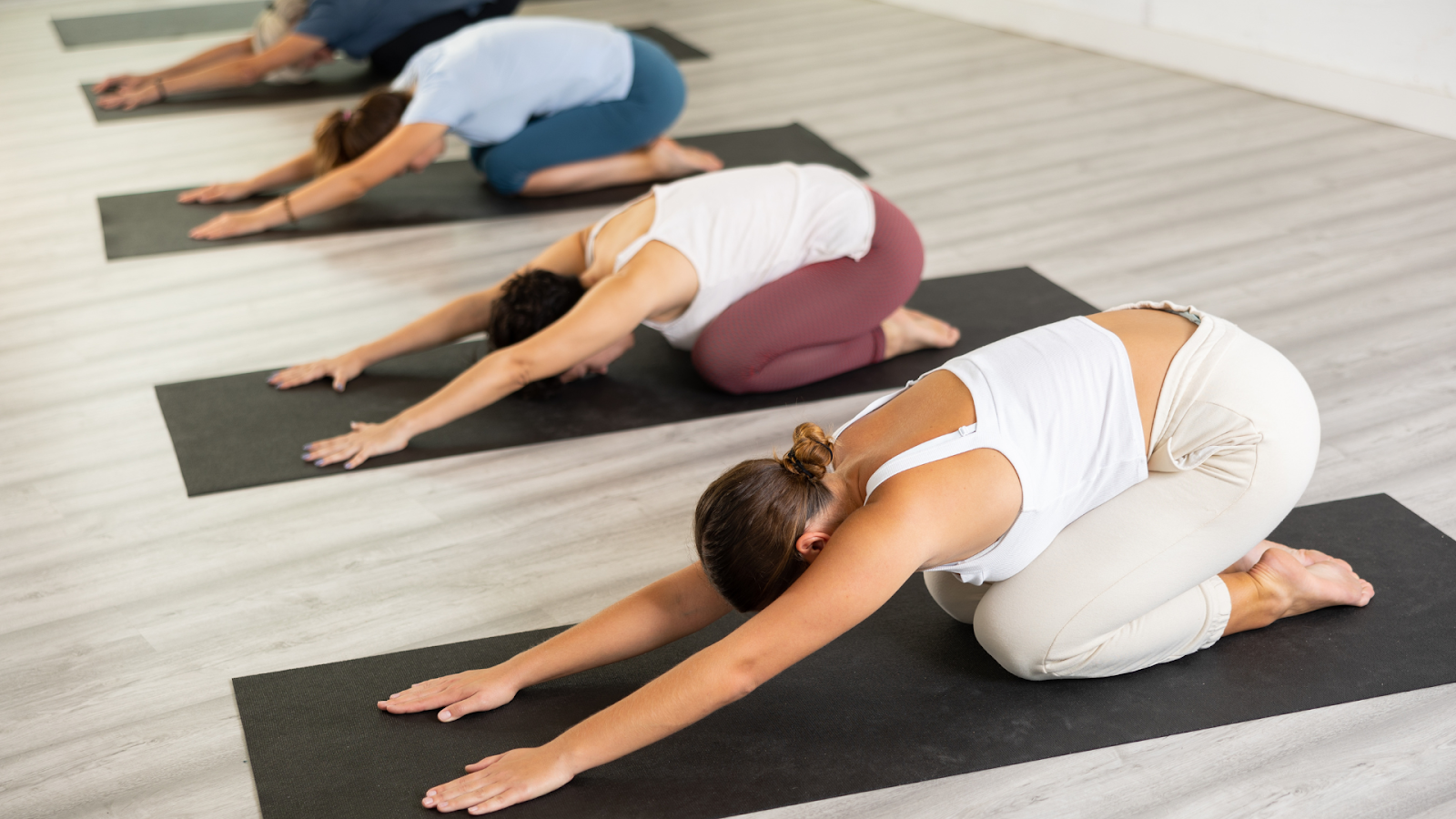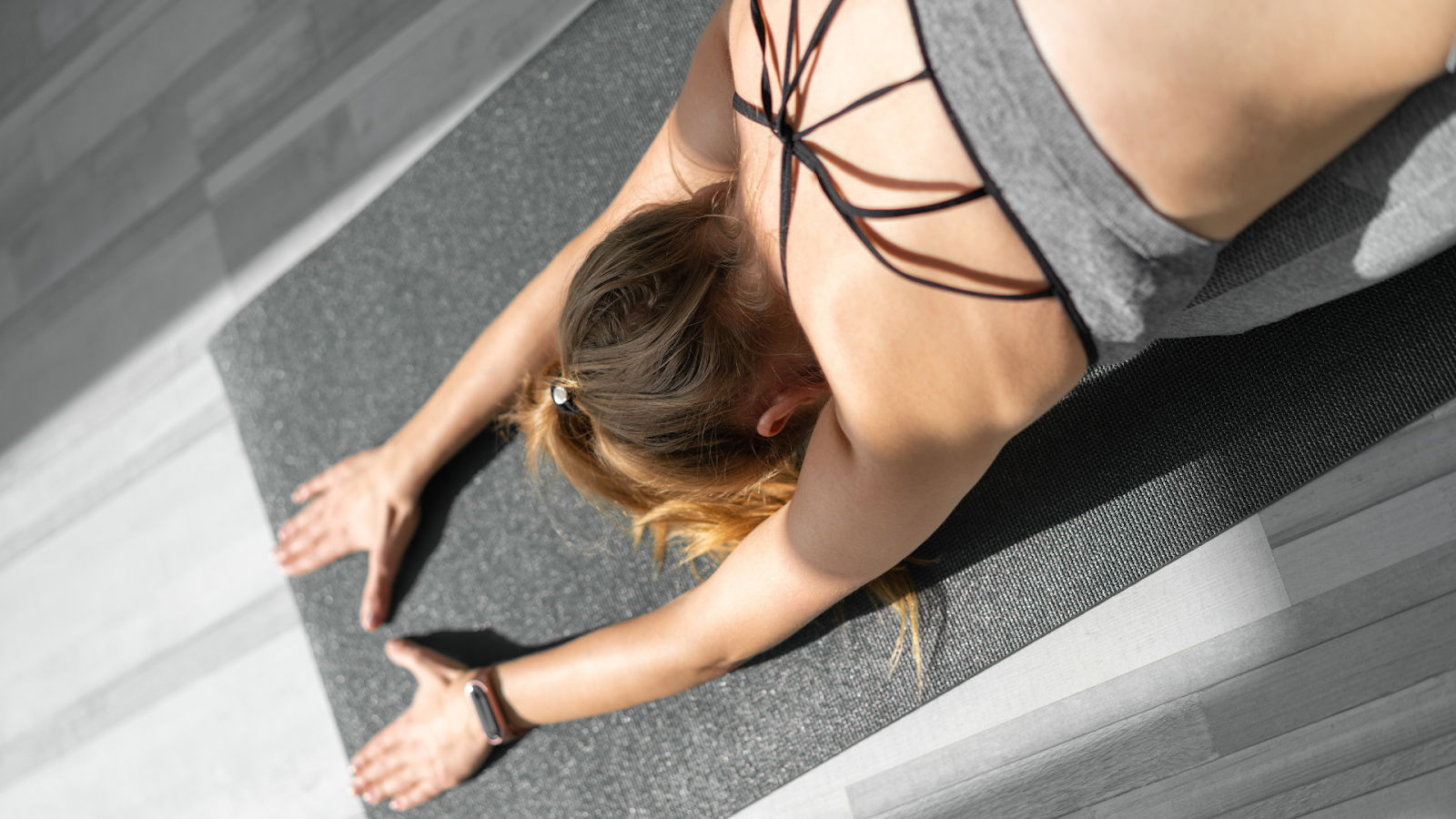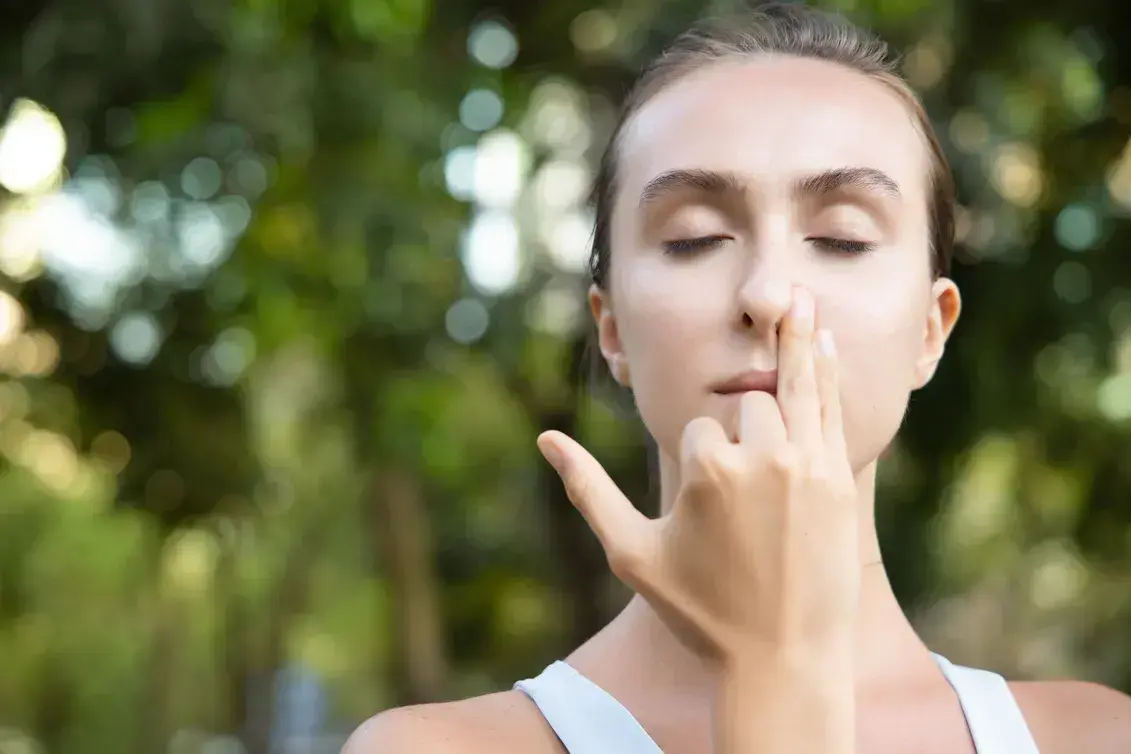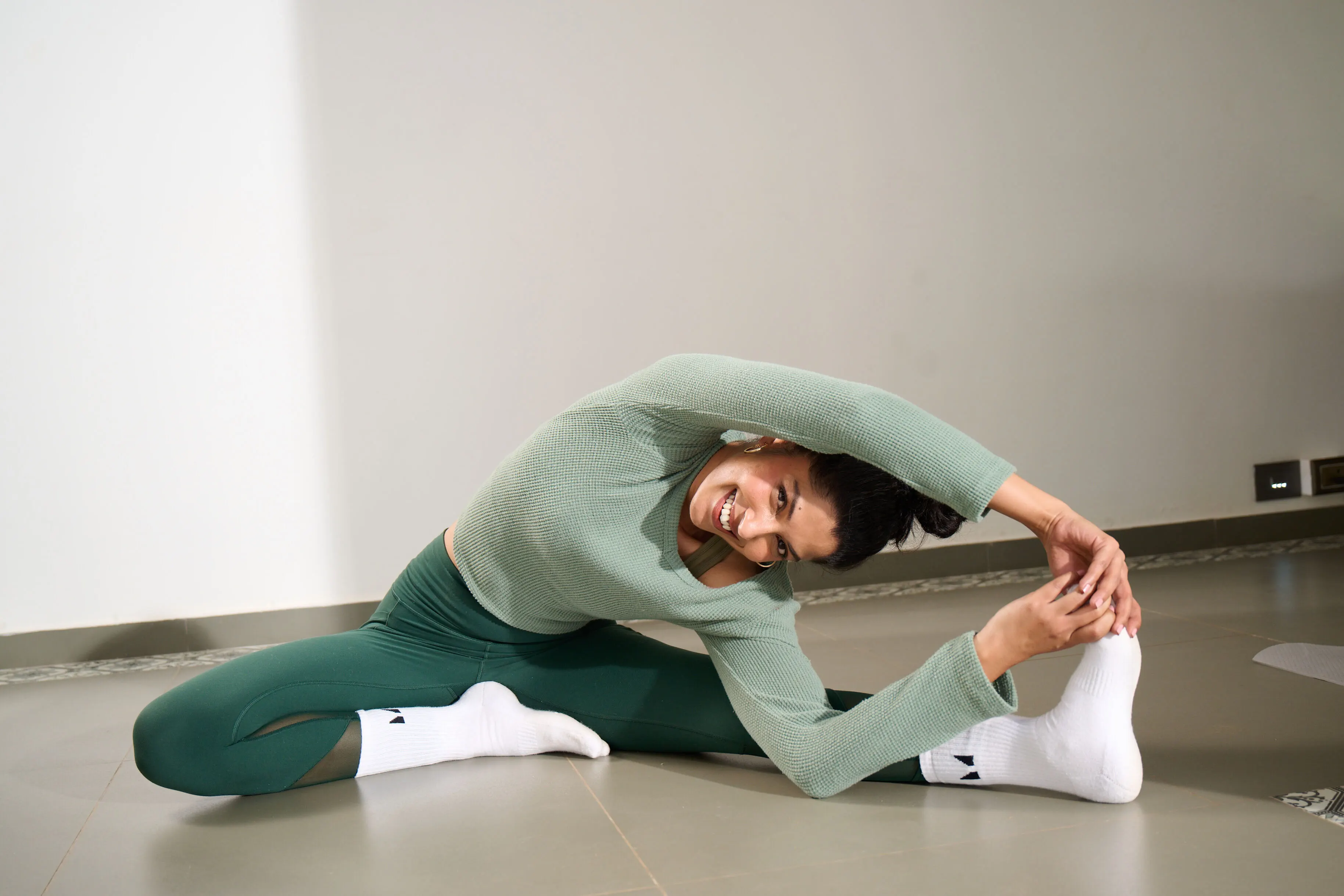What is the Child’s Pose?
Child's Pose, also known as Balasana, is a gentle yoga posture that provides a sense of calm and relaxation. In this pose, practitioners kneel on the floor in Vajrasana (Thunderbolt Pose), and stretch their arms forward, resting their forehead on the mat. This position helps to gently stretch the hips, thighs, and ankles while relieving stress and fatigue. Child's Pose is often used as a resting position during yoga sequences, allowing individuals to reconnect with their breath and center themselves. Its soothing nature makes it ideal for beginners and experienced yogis alike, offering a moment of introspection and tranquility.
Position type: Kneeling
Posture type: Restorative
Ideal for: Relaxing
Targets: Legs and back
Pose level: Beginner
How to prepare for the Child’s pose?
This relaxing and restorative posture requires no special preparation. It can be practiced at the beginning of a yoga class, as a restful pause between asanas for a few deep breaths, or at the end of a session to wind down. Balasana is also beneficial on its own after a long day, just before bed. If you’re feeling stressed, experiencing body soreness, or dealing with any aches, practicing Child’s Pose can help relax and alleviate tension.
How to do Child’s Pose?
Getting into the posture:
- Start on your hands and knees in a tabletop position. Bring your big toes together and sit back on your heels in Vajrasana.
- Gently separate your knees about hip-width apart or wider, depending on what feels comfortable for your body.
- Reach your arms forward, extending them in front of you. Alternatively, you can bring your arms alongside your body with your palms facing up.
- Slowly lower your torso down between your thighs, resting your forehead on the mat.
- Close your eyes, relax your shoulders, and take deep, slow breaths. Hold the pose for as long as comfortable, allowing your body to release tension and your mind to calm.
Getting out of the posture: To come out of the pose, first raise the head up, then the torso and sit back in Vajrasana. You can slowly come out of Vajrasana and relax.
What are the benefits of doing Child’s pose?

Balasana is a gentle and restorative yoga posture with numerous benefits for both the body and mind. It helps to stretch the hips, thighs, and ankles, promoting flexibility and relieving tension in these areas. This pose also aids in reducing stress and anxiety by encouraging deep, mindful breathing, which calms the nervous system. Balasana can alleviate lower back pain and improve spinal alignment, making it an excellent choice for those seeking relief from back discomfort. Additionally, it promotes relaxation and mental clarity, providing a restful break during yoga practice or throughout the day. The gentle forward fold of Child's Pose also enhances circulation and can aid in digestion.
What are the contraindications of Child’s Pose?
While Child's Pose is generally safe and beneficial, there are certain contraindications to be aware of. Individuals with knee injuries or severe knee pain should avoid this pose or practice it with caution, as it can put pressure on the knees. Those with hip or ankle issues might also find discomfort in this position. Pregnant women should be cautious, especially in the later stages of pregnancy, and might need to modify the pose to avoid compressing the abdomen. They should also practice under the guidance of an experienced teacher.People with high blood pressure or inner ear infections should avoid lowering the head to the floor. Additionally, anyone with shoulder injuries should be careful when extending the arms forward.
Counter poses for Child’s Pose:
There are no counter poses necessary as this is a relaxing posture. You can continue your yoga asana practice if you are doing the child’s pose to rest between asanas. Or, once you come into Vajrasana, you can also come up to the tabletop position and come into Downward-facing Dog Pose.
Variations of Child’s Pose:

- Place a bolster or a thick, folded blanket under your torso, resting your chest and head on it. This variation offers extra support and is particularly beneficial for those with knee, hip, or back issues. It allows you to experience the calming benefits of Child's Pose with less strain on the joints.
- Begin in the usual Child's Pose position but spread your knees wider apart, almost to the edges of your mat. This variation allows for a deeper stretch in the hips and can create more space for your torso to rest between your legs, making it more comfortable for those with a larger body or tight hips.
- From the traditional Child's Pose, extend your arms further forward, spreading your fingers wide and pressing your palms into the mat. This is the Puppy pose variation and it provides a deeper stretch for the shoulders, arms, and upper back.
Advice for Beginners: For beginners practicing Child's Pose, it's important to focus on comfort and relaxation. Keep your knees as wide apart as feels comfortable, and don't hesitate to use props like a folded blanket or cushion under your torso or between your knees for added support. Keep your forehead resting gently on the mat or a block to avoid straining your neck. Breathe deeply and slowly, allowing your body to release tension with each exhale. If you experience any discomfort in your knees or hips, modify the pose or take a break. Remember, the goal is to relax and find a sense of peace in the posture.
Shvasa tips for Child’s Pose:
- Deep, mindful breathing is essential in Child's Pose. As you settle into the pose, focus on taking slow, deep breaths. This helps to calm the mind and enhance the relaxation benefits of the posture.
- Child's Pose is meant to be restful and gentle. If you feel any discomfort or strain, make adjustments to your position. Widen your knees if you need more space for your torso, or bring them closer together if it feels better for your hips and back.
- Always prioritize your comfort and ease in the pose. Do not hesitate to use props for support whenever you feel like you need it.
Join a live yoga class to experience the wonderful relaxing benefits of practicing Child’s Pose.
Meta Description: Learn how to practice Child’s pose. Benefits, precautions, modifications and practice tips for Balasana.
Summary: Child's Pose is often used as a resting position during yoga sequences, allowing individuals to reconnect with their breath and center themselves. Practice Child’s pose in live yoga classes to experience immense relaxation.
FAQs:
- What is the Child’s Pose?
Child's Pose, also known as Balasana, is a gentle yoga posture that provides a sense of calm and relaxation. In this pose, practitioners kneel on the floor in Vajrasana (Thunderbolt Pose), and stretch their arms forward, resting their forehead on the mat. This position helps to gently stretch the hips, thighs, and ankles while relieving stress and fatigue. Child's Pose is often used as a resting position during yoga sequences, allowing individuals to reconnect with their breath and center themselves. Its soothing nature makes it ideal for beginners and experienced yogis alike, offering a moment of introspection and tranquility.
- What are the benefits of doing Child’s pose?
Balasana is a gentle and restorative yoga posture with numerous benefits for both the body and mind. It helps to stretch the hips, thighs, and ankles, promoting flexibility and relieving tension in these areas. This pose also aids in reducing stress and anxiety by encouraging deep, mindful breathing, which calms the nervous system. Balasana can alleviate lower back pain and improve spinal alignment, making it an excellent choice for those seeking relief from back discomfort.
- What are the contraindications of Child’s Pose?
While Child's Pose is generally safe and beneficial, there are certain contraindications to be aware of. Individuals with knee injuries or severe knee pain should avoid this pose or practice it with caution, as it can put pressure on the knees. Those with hip or ankle issues might also find discomfort in this position.
- How to do Child’s Pose?
- Start on your hands and knees in a tabletop position. Bring your big toes together and sit back on your heels in Vajrasana.
- Gently separate your knees about hip-width apart or wider, depending on what feels comfortable for your body.
- Reach your arms forward, extending them in front of you. Alternatively, you can bring your arms alongside your body with your palms facing up.
- Slowly lower your torso down between your thighs, resting your forehead on the mat.
- Close your eyes, relax your shoulders, and take deep, slow breaths. Hold the pose for as long as comfortable, allowing your body to release tension and your mind to calm.















.jpg)











%201.png)

%201.svg)






%201.svg)